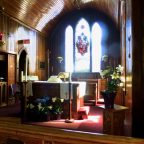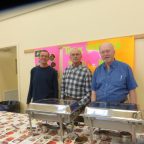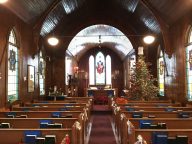Born in a Stable? Not Really! (December 14, 2018)
One of the decorations I collect for this time of year is the crèche—a rough stable, with Mary and Joseph gazing at their newborn son laid in a manger, attended by shepherds and wise men and assorted animals. That’s the story, right? “She gave birth to her firstborn son and wrapped him in bands of cloth, and laid him in a manger, because there was no room for them in the inn” (Luke 2:7).
Quite naturally, our minds think that all the Best Westerns and Super 8’s in Bethlehem were full because of the crowds coming for the census, and the only space available to this weary couple was the stable behind the inn.
I’m sorry to spoil it, but my crèches are wrong. It just ain’t so.
So where does this idea come from? Let me suggest that the misunderstanding is mainly due to two elements: issues of grammar and meaning, and a lack of knowledge about 1st century Palestinian culture.
Let’s start with grammar and meaning. The Greek word in Luke 2 is “kataluma”. It is translated as “inn, guestroom, or hostel”. Interestingly, Luke uses the same word in Luke 22:11 when Jesus gathers with his disciples near the end of his life for the last supper … and there, the word is translated as “upper room” or “guest room”. That’s really what the word means.
Kenneth Bailey, a scholar renowned for his study of life in 1st–century Palestine, tells us in his book “Jesus Through Middle–Eastern Eyes” that at the time, most families lived in a single–room house. There was a lower area where animals would be brought in at night. The family living area would usually have hollows in the ground near that lower area, filled with straw where the animals would feed. There would also be a room at the back or on the roof for visitors. That’s the “kataluma”, a place for visitors.
As Luke tells the story, Bethlehem was bustling with people for the Roman census (by the way, there is no historical evidence for the census). As a result, Joseph and Mary couldn’t find any space in the guest room of their relatives in town.
Here’s where the second element comes in. In 1st century Palestine, it would be unthinkable that Joseph would not have been received by family members as he returned to the place of his ancestral origins, even if they were not close relatives. It was a culture of hospitality, and family ties were even more important than they are now. They were the glue that helped peasant society stay together.
Joseph could appear suddenly at the home of a distant cousin, recite his genealogy, and be instantly among friends and family who would welcome him with open arms. At the same time, family ties insisted that Joseph would have been honour–bound to seek out his relatives.
So when Luke writes that the “kataluma” had no space, it means that the family guest room is already full with other family visitors. As a result, Joseph and Mary would stay with the family itself, in the main room of the house. That’s where Mary gives birth. The women would likely have chased the men out of the room and attended her. After being born, she would wrap her son in linen cloth, and lay him in the straw–filled depressions near the lower end of the house where the animals are fed.
In other words, Mary and Joseph were not in a stable at the back of a hotel, alone and outcast. That would simply not be possible in that time and place.
Bailey quotes an earlier writer with some amusement, “Anyone who has lodged with Palestinian peasants knows that notwithstanding their hospitality, the lack of privacy is unspeakably painful. One cannot have a room to oneself, and one is never alone by day or by night. I myself often fled into the open country simply in order to be able to think.”
The Christmas story is not about Jesus being sad and lonely at his birth, some distance away in a stable. Rather, Jesus is born in the midst of the family and all the relatives. He is born in the thick of it all, and that’s where the shepherds come to worship. (The magi don’t enter this story at all—that’s Matthew’s story, and they visit the house in Bethlehem!)
The interesting thing is that this interpretation of the story isn’t particularly new. A Presbyterian missionary to Lebanon and Syria, William Thomason, wrote in 1857 that “the birth actually took place in an ordinary house of some common peasant, and that the baby was laid in one of the mangers, such as are still found in the dwellings of farmers in this region.” In an influential commentary from the late 19th century, Alfred Plummer agreed with this take on the story.
So why has the traditional interpretation persisted for so long?
I think there are two main reasons.
First of all, it’s hard for us to forget our own culture and our own assumptions. When we read inn, we naturally think motel—Prestige Inn or Motel 6. And the animals—well they’re kept away from the family of course! So that is where Jesus must have been born. Out back. In a stable.
Secondly, this traditional interpretation is enshrined in carol and legend, and no matter how hard we try, it’s difficult to let go of this traditional understanding. We grew up with it. We sing the familiar carols and listen to the favourite themes of Christmas preachers which emphasize “a lowly cattle shed” and “a draughty stable with an open door”.
The difficulty with the stable is that it distances Jesus from the rest of us. The upper room places Jesus in a human environment with which we can identify much more clearly.
Rev. Yme Woensdregt







